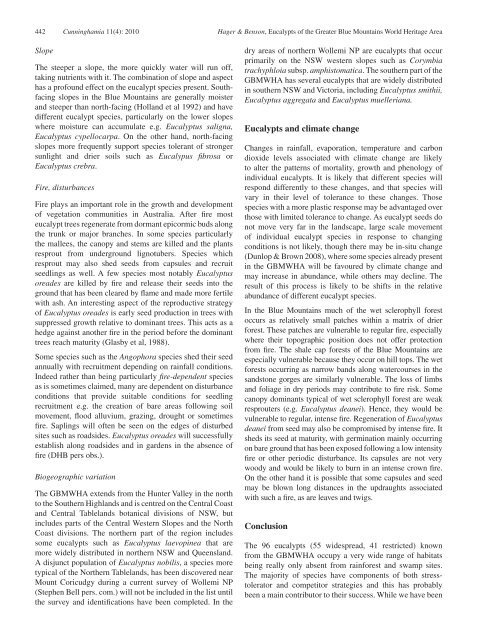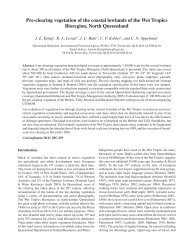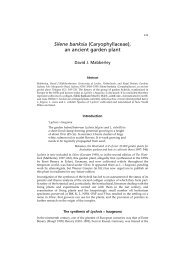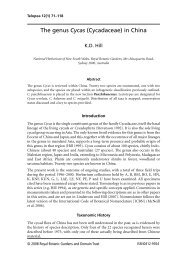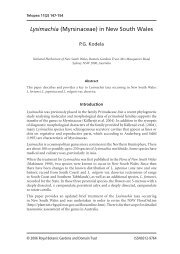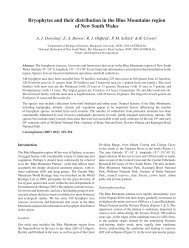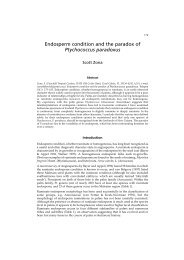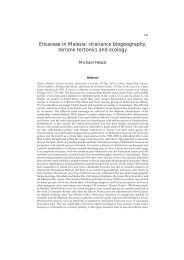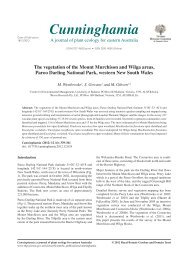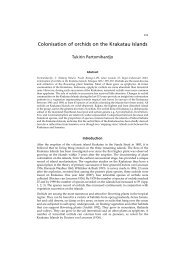The Eucalypts of the Greater Blue Mountains World Heritage Area ...
The Eucalypts of the Greater Blue Mountains World Heritage Area ...
The Eucalypts of the Greater Blue Mountains World Heritage Area ...
Create successful ePaper yourself
Turn your PDF publications into a flip-book with our unique Google optimized e-Paper software.
442 Cunninghamia 11(4): 2010 Hager & Benson, <strong>Eucalypts</strong> <strong>of</strong> <strong>the</strong> <strong>Greater</strong> <strong>Blue</strong> <strong>Mountains</strong> <strong>World</strong> <strong>Heritage</strong> <strong>Area</strong><br />
Slope<br />
<strong>The</strong> steeper a slope, <strong>the</strong> more quickly water will run <strong>of</strong>f,<br />
taking nutrients with it. <strong>The</strong> combination <strong>of</strong> slope and aspect<br />
has a pr<strong>of</strong>ound effect on <strong>the</strong> eucalypt species present. Southfacing<br />
slopes in <strong>the</strong> <strong>Blue</strong> <strong>Mountains</strong> are generally moister<br />
and steeper than north-facing (Holland et al 1992) and have<br />
different eucalypt species, particularly on <strong>the</strong> lower slopes<br />
where moisture can accumulate e.g. Eucalyptus saligna,<br />
Eucalyptus cypellocarpa. On <strong>the</strong> o<strong>the</strong>r hand, north-facing<br />
slopes more frequently support species tolerant <strong>of</strong> stronger<br />
sunlight and drier soils such as Eucalypus fibrosa or<br />
Eucalyptus crebra.<br />
Fire, disturbances<br />
Fire plays an important role in <strong>the</strong> growth and development<br />
<strong>of</strong> vegetation communities in Australia. After fire most<br />
eucalypt trees regenerate from dormant epicormic buds along<br />
<strong>the</strong> trunk or major branches. In some species particularly<br />
<strong>the</strong> mallees, <strong>the</strong> canopy and stems are killed and <strong>the</strong> plants<br />
resprout from underground lignotubers. Species which<br />
resprout may also shed seeds from capsules and recruit<br />
seedlings as well. A few species most notably Eucalyptus<br />
oreades are killed by fire and release <strong>the</strong>ir seeds into <strong>the</strong><br />
ground that has been cleared by flame and made more fertile<br />
with ash. An interesting aspect <strong>of</strong> <strong>the</strong> reproductive strategy<br />
<strong>of</strong> Eucalyptus oreades is early seed production in trees with<br />
suppressed growth relative to dominant trees. This acts as a<br />
hedge against ano<strong>the</strong>r fire in <strong>the</strong> period before <strong>the</strong> dominant<br />
trees reach maturity (Glasby et al, 1988).<br />
Some species such as <strong>the</strong> Angophora species shed <strong>the</strong>ir seed<br />
annually with recruitment depending on rainfall conditions.<br />
Indeed ra<strong>the</strong>r than being particularly fire-dependent species<br />
as is sometimes claimed, many are dependent on disturbance<br />
conditions that provide suitable conditions for seedling<br />
recruitment e.g. <strong>the</strong> creation <strong>of</strong> bare areas following soil<br />
movement, flood alluvium, grazing, drought or sometimes<br />
fire. Saplings will <strong>of</strong>ten be seen on <strong>the</strong> edges <strong>of</strong> disturbed<br />
sites such as roadsides. Eucalyptus oreades will successfully<br />
establish along roadsides and in gardens in <strong>the</strong> absence <strong>of</strong><br />
fire (DHB pers obs.).<br />
Biogeographic variation<br />
<strong>The</strong> GBMWHA extends from <strong>the</strong> Hunter Valley in <strong>the</strong> north<br />
to <strong>the</strong> Sou<strong>the</strong>rn Highlands and is centred on <strong>the</strong> Central Coast<br />
and Central Tablelands botanical divisions <strong>of</strong> NSW, but<br />
includes parts <strong>of</strong> <strong>the</strong> Central Western Slopes and <strong>the</strong> North<br />
Coast divisions. <strong>The</strong> nor<strong>the</strong>rn part <strong>of</strong> <strong>the</strong> region includes<br />
some eucalypts such as Eucalyptus laevopinea that are<br />
more widely distributed in nor<strong>the</strong>rn NSW and Queensland.<br />
A disjunct population <strong>of</strong> Eucalyptus nobilis, a species more<br />
typical <strong>of</strong> <strong>the</strong> Nor<strong>the</strong>rn Tablelands, has been discovered near<br />
Mount Coricudgy during a current survey <strong>of</strong> Wollemi NP<br />
(Stephen Bell pers. com.) will not be included in <strong>the</strong> list until<br />
<strong>the</strong> survey and identifications have been completed. In <strong>the</strong><br />
dry areas <strong>of</strong> nor<strong>the</strong>rn Wollemi NP are eucalypts that occur<br />
primarily on <strong>the</strong> NSW western slopes such as Corymbia<br />
trachyphloia subsp. amphistomatica. <strong>The</strong> sou<strong>the</strong>rn part <strong>of</strong> <strong>the</strong><br />
GBMWHA has several eucalypts that are widely distributed<br />
in sou<strong>the</strong>rn NSW and Victoria, including Eucalyptus smithii,<br />
Eucalyptus aggregata and Eucalyptus muelleriana.<br />
<strong>Eucalypts</strong> and climate change<br />
Changes in rainfall, evaporation, temperature and carbon<br />
dioxide levels associated with climate change are likely<br />
to alter <strong>the</strong> patterns <strong>of</strong> mortality, growth and phenology <strong>of</strong><br />
individual eucalypts. It is likely that different species will<br />
respond differently to <strong>the</strong>se changes, and that species will<br />
vary in <strong>the</strong>ir level <strong>of</strong> tolerance to <strong>the</strong>se changes. Those<br />
species with a more plastic response may be advantaged over<br />
those with limited tolerance to change. As eucalypt seeds do<br />
not move very far in <strong>the</strong> landscape, large scale movement<br />
<strong>of</strong> individual eucalypt species in response to changing<br />
conditions is not likely, though <strong>the</strong>re may be in-situ change<br />
(Dunlop & Brown 2008), where some species already present<br />
in <strong>the</strong> GBMWHA will be favoured by climate change and<br />
may increase in abundance, while o<strong>the</strong>rs may decline. <strong>The</strong><br />
result <strong>of</strong> this process is likely to be shifts in <strong>the</strong> relative<br />
abundance <strong>of</strong> different eucalypt species.<br />
In <strong>the</strong> <strong>Blue</strong> <strong>Mountains</strong> much <strong>of</strong> <strong>the</strong> wet sclerophyll forest<br />
occurs as relatively small patches within a matrix <strong>of</strong> drier<br />
forest. <strong>The</strong>se patches are vulnerable to regular fire, especially<br />
where <strong>the</strong>ir topographic position does not <strong>of</strong>fer protection<br />
from fire. <strong>The</strong> shale cap forests <strong>of</strong> <strong>the</strong> <strong>Blue</strong> <strong>Mountains</strong> are<br />
especially vulnerable because <strong>the</strong>y occur on hill tops. <strong>The</strong> wet<br />
forests occurring as narrow bands along watercourses in <strong>the</strong><br />
sandstone gorges are similarly vulnerable. <strong>The</strong> loss <strong>of</strong> limbs<br />
and foliage in dry periods may contribute to fire risk. Some<br />
canopy dominants typical <strong>of</strong> wet sclerophyll forest are weak<br />
resprouters (e.g. Eucalyptus deanei). Hence, <strong>the</strong>y would be<br />
vulnerable to regular, intense fire. Regeneration <strong>of</strong> Eucalyptus<br />
deanei from seed may also be compromised by intense fire. It<br />
sheds its seed at maturity, with germination mainly occurring<br />
on bare ground that has been exposed following a low intensity<br />
fire or o<strong>the</strong>r periodic disturbance. Its capsules are not very<br />
woody and would be likely to burn in an intense crown fire.<br />
On <strong>the</strong> o<strong>the</strong>r hand it is possible that some capsules and seed<br />
may be blown long distances in <strong>the</strong> updraughts associated<br />
with such a fire, as are leaves and twigs.<br />
Conclusion<br />
<strong>The</strong> 96 eucalypts (55 widespread, 41 restricted) known<br />
from <strong>the</strong> GBMWHA occupy a very wide range <strong>of</strong> habitats<br />
being really only absent from rainforest and swamp sites.<br />
<strong>The</strong> majority <strong>of</strong> species have components <strong>of</strong> both stresstolerator<br />
and competitor strategies and this has probably<br />
been a main contributor to <strong>the</strong>ir success. While we have been


